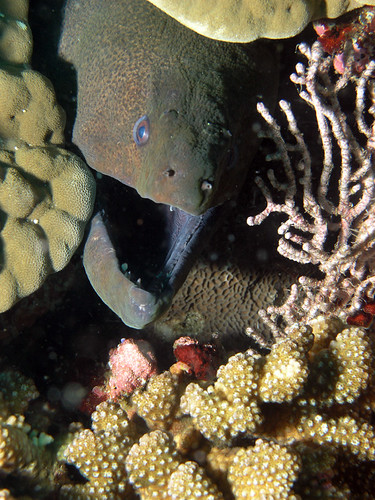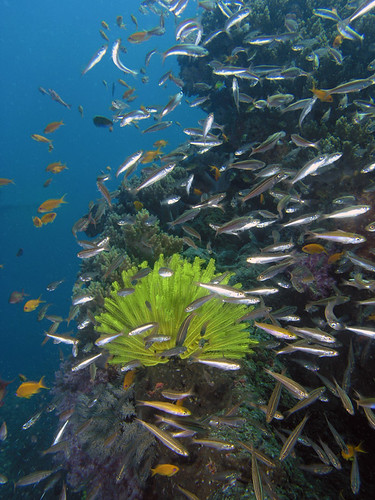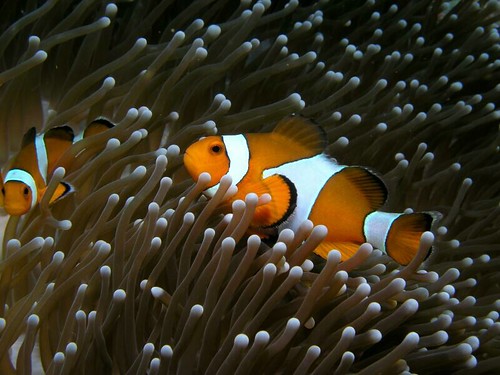An interview with Niphon Phongsuwan,
Project Leader, Green Fins Project
Phuket Marine Biological Center, Phuket, Thailand
THE GREEN FINS PROGRAMME
Thailand joins The Philippines in being actively engaged with Green Fins.
Coral reefs are an important resource in Southeast Asia, contributing to the economic incomes of the coastal population and the growing dive tourism industry in this region. The East Asian Seas region contains one of the greatest concentrations of coral reefs in the world. The area is so rich in biodiversity that more coral and reef fish species can be found here than anywhere else. The coral reefs of the region can be regarded as a classic example of a rich and diverse ecosystem.
 Map of global coral diversity from the World Resources Institute Please click to expand
Map of global coral diversity from the World Resources Institute Please click to expandThe main reason the participating countries were selected is recognition of the importance of the Indo-Pacific in terms of their contribution to global marine biodiversity. As this inevitably makes countries in the region popular dive sites, there is the risk that they will be adversely impacted by dive tourism if conservation measures are not introduced pro-actively.
To promote the protection and preservation of the marine environment, a new project called Green Fins is being rolled out in Thailand. An initiative of the Coordinating Body of the Seas of East Asia (COBSEA), United Nations Environmental Programme (UNEP), the Green Fins mission is “to protect and conserve coral reefs by establishing and implementing environmentally friendly guidelines to promote a sustainable diving tourism industry”.
With decades of sustained growth in Thailand’s economic and tourism development, the impact of human activity on coral reefs is apparent. In the past, human impact on Thailand’s coral reefs were primarily from unsustainable practices such as dynamite and poison fishing. While these factors have not disappeared altogether, the environmental impact from dive tourism is potentially of more significance now. For example, the island of Koh Tao, a diving Mecca off the coast of Chumphon Province and Thailand’s most popular diving destination for all dive beginners, accounts for approximately 30 per cent of all dive certificates issued around the world. With the large numbers of divers visiting this island and other diving hotspots, inexperienced divers, reef-walking snorkellers and underwater photographers, as well as dive boat anchors, cause direct physical damage to coral.


Images © Phuket Marine Biological Center, Phuket, Thailand
Human-induced climate change is also leading to changes in temperature and sea level which in turn are causing changes in reef communities, such as bleaching and disease. This makes it all the more important to reduce the impact people have on this fragile ecosystem.
While climate change is inevitable, minimizing the impact from tourism-related activities can be more easily achieved.
HOW YOU CAN HELPSUSTAINING THE PROGAMME
Individuals and organizations will in future be able to join a Green Fins Club. This will promote interest in the conservation of reefs.
Funding support from the private sector will help fund activities and monitoring of the programme. Ultimately the success of the programme will depend on the extent to which it can be sustained.
Green Fins can eventually become a part of official Thailand Government marine conservation programmes, and so be supported through annual budgets and sustained through forward planning.
Source Reference :www.TATnews.org Read more!Source Photo : Images © Phuket Marine Biological Center, Phuket, Thailand
*Sources
1 Tourism Authority of Thailand
2 Department of Marine and Coastal Resources





 ROYAL Phuket Marina's phase 2 development was officially launched at a round breaking ceremony, late last month, attended by island's governor, Narin Kalayanmit, and the marina's owner and developer,
ROYAL Phuket Marina's phase 2 development was officially launched at a round breaking ceremony, late last month, attended by island's governor, Narin Kalayanmit, and the marina's owner and developer, 
 The marina is double the size of any other yachting haven in Phuket, with 350 berths for yachts up to 30 metres long. It claims to be the only facility with a non tidal boat lock, deep water basin and private moorings on the doorstep of residences.
The marina is double the size of any other yachting haven in Phuket, with 350 berths for yachts up to 30 metres long. It claims to be the only facility with a non tidal boat lock, deep water basin and private moorings on the doorstep of residences.







 The site consists of 4 interconnected underwater pinnacles which tower up form around 34m; the highest peaks are 16m. Below the surface. This is an ideal place to spot many pelagics. Large schools of great barracuda, big-eye jacks, tuna, mackerel, goldbody and giant trevally are all frequent visitor. Whale sharks, with accompanying striped than any other site in the Gulf.
The site consists of 4 interconnected underwater pinnacles which tower up form around 34m; the highest peaks are 16m. Below the surface. This is an ideal place to spot many pelagics. Large schools of great barracuda, big-eye jacks, tuna, mackerel, goldbody and giant trevally are all frequent visitor. Whale sharks, with accompanying striped than any other site in the Gulf.



 Bigger fish such as leopard sharks and grey reef sharks are occasionally seen here and Indonesian bamboo sharks are becoming a more common sight beneath coral heads following a recent breeding program by the Phuket Marine Biological Research Centre. Octopuses are also common on the walls and if you look up you can normally see crocodile long-toms swimming close to the surface.
Bigger fish such as leopard sharks and grey reef sharks are occasionally seen here and Indonesian bamboo sharks are becoming a more common sight beneath coral heads following a recent breeding program by the Phuket Marine Biological Research Centre. Octopuses are also common on the walls and if you look up you can normally see crocodile long-toms swimming close to the surface.
 If you ever come across a dive buddy who claims in their log book to have seen a yellow submarine at Koh Dok Mai, then it's not necessarily likely that they took too many hallucinogenic drugs in the 1960's. One Phuket tour operator here did take non-diving tourists down on submarine tours around the island to goggle at the marine life. Thankfully, they don't play the accompanying music to the passenger.
If you ever come across a dive buddy who claims in their log book to have seen a yellow submarine at Koh Dok Mai, then it's not necessarily likely that they took too many hallucinogenic drugs in the 1960's. One Phuket tour operator here did take non-diving tourists down on submarine tours around the island to goggle at the marine life. Thankfully, they don't play the accompanying music to the passenger.


 Richelieu Rock rates as one of the best places in the world to dive with whale sharks and is easily the best site in Thailand diving for this amazing activity. It's not the only Thailand dive destination where whale sharks are seen but Richelieu Rock certainly attracts more than its fair share. Schooling Chevron Barracuda, numerous types of Moray Eels, abundant LionFish and Scorpion Fish. 5 types of Anemone Fish, Juvenile Emperor Angel Fish, Sea Horses, Ornate Ghost PipeFish and Harlequin Shrimps can all be found. This site is also a prime location for sighting Whalesharks, occasional Manta Rays and ShovelNose Rays.
Richelieu Rock rates as one of the best places in the world to dive with whale sharks and is easily the best site in Thailand diving for this amazing activity. It's not the only Thailand dive destination where whale sharks are seen but Richelieu Rock certainly attracts more than its fair share. Schooling Chevron Barracuda, numerous types of Moray Eels, abundant LionFish and Scorpion Fish. 5 types of Anemone Fish, Juvenile Emperor Angel Fish, Sea Horses, Ornate Ghost PipeFish and Harlequin Shrimps can all be found. This site is also a prime location for sighting Whalesharks, occasional Manta Rays and ShovelNose Rays.

 Swimming with such a large animal, known to grow to fourteen metres in length, is a never to be forgotten experience for any diver. Sightings occur about 10% of the time. Some dive seasons see more visitors than others and generally February to April is the best time for a visit if your aim is to enjoy the exhilaration of swimming with these massive creatures onboard liveaboards in Thailand.
Swimming with such a large animal, known to grow to fourteen metres in length, is a never to be forgotten experience for any diver. Sightings occur about 10% of the time. Some dive seasons see more visitors than others and generally February to April is the best time for a visit if your aim is to enjoy the exhilaration of swimming with these massive creatures onboard liveaboards in Thailand.


 Conversely, the dive sites in the Gulf of Thailand are at their best during this season, with only minimal winds and seas. Visibility can sometimes equal that of the Andaman Sea during this period. There are always dive sites on either side of the Isthmus that are sheltered enough to be dived whatever the weather so, if you find in the wrong place at the wrong time, don't despair!
Conversely, the dive sites in the Gulf of Thailand are at their best during this season, with only minimal winds and seas. Visibility can sometimes equal that of the Andaman Sea during this period. There are always dive sites on either side of the Isthmus that are sheltered enough to be dived whatever the weather so, if you find in the wrong place at the wrong time, don't despair!





